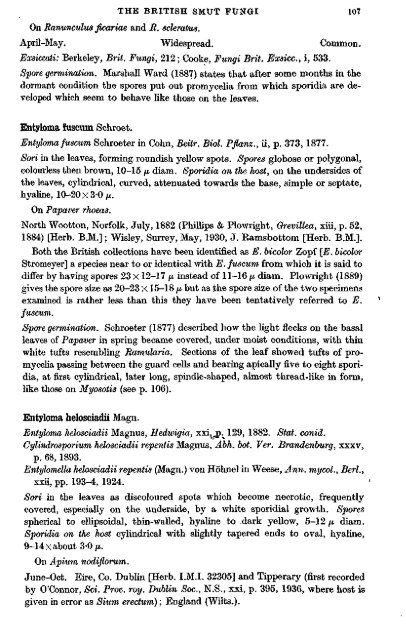nmm sP
nmm sP
nmm sP
Create successful ePaper yourself
Turn your PDF publications into a flip-book with our unique Google optimized e-Paper software.
On Ranunculus ficariae and B. scleratus.<br />
THE BEITISH SMUT FUNGI 107<br />
April-May. Widespread. Common.<br />
Exsiccati: Berkeley, Brit. Fungi, 212; Cooke, Fungi Brit. Exsicc., i, 533.<br />
Spore germination. Marshall Ward (1887) states that after some months in the<br />
dormant condition the spores put out promycelia from which sporidia are developed<br />
which seem to behave like those on the leaves.<br />
Entyloma fuscum Schroet.<br />
Entyloma fuscum Schroeter in Cohn, Beitr. Biol. Pflanz., ii, p. 373, 1877.<br />
Sari in the leaves, forming roundish yellow spots. Spores globose or polygonal,<br />
colourless then brown, 10-16 /oi diam. Sporidia on the host, on the undersides of<br />
the leaves, cylindrical, curved, attenuated towards the base, simple or septate,<br />
hyaline, 10-20 X 3-0/x.<br />
On Papaver rhoeas.<br />
North Wootton, Norfolk, July, 1882 (Phillips & Plowright, Grevillea, xiii, p. 52,<br />
1884) [Herb. B.M.]; Wisley, Surrey, May, 1930, J. Ramsbottom [Herb. B.M.].<br />
Both the British collections have been identified as E. bicohr Zopf [E. bicolor<br />
Stromeyer] a species near to or identical with E. fuscum from which it is said to<br />
differ by having spores 23 X12-17 jx instead of 11-16 /n diam. Plowright (1889)<br />
gives the spore size as 20-23 X15-18 ju, but as the spore size of the two specimens<br />
examined is rather less than this they have been tentatively referred to E.<br />
fuscum.<br />
Spore germination. Schroeter (1877) described how the hght flecks on the basal<br />
leaves of Papaver in spring became covered, under moist conditions, with thin<br />
white tufts resembling Ramularia. Sections of the leaf showed tufts of promycelia<br />
passing between the guard cells and bearing apically five to eight sporidia,<br />
at first cylindrical, later long, spindle-shaped, almost thread-like in form,<br />
like those on Myosotis (see p. 106).<br />
Entyloma helosciadii Magn.<br />
Entyloma helosciadii Magnus, Hedwigia, xxi, j).^ 129, 1882. Stat, conid.<br />
Cylindrosporium helosciadii repentis Magnus, Abh. bat. Ver. Brandenburg, xxxv,<br />
p. 68, 1893.<br />
Entylomella helosciadii repentis (Magn.) von Hohnel in Weese, Ann. mycol., Berl.,<br />
xxii, pp. 193-4, 1924.<br />
Sori in the leaves as discoloured spots which become necrotic, frequently<br />
covered, especially on the underside, by a white sporidial growth. Spores<br />
spherical to elhpsoidal, thin-walled, hyaline to dark yellow, 5-12 fi diam.<br />
Sporidia on the host cylindrical with shghtly tapered ends to oval, hyaline,<br />
9-14 X about 3-0/i.<br />
On Apium nodiflorum.<br />
June-Oct. Eire, Co. Dublin [Herb. I.M.I. 32305] and Tipperary (first recorded<br />
by O'Connor, Sci. Proc. roy. Dublin Soc, N.S., xxi, p. 395, 1936, where host is<br />
given in error as Sium erectum); England (Wilts.).

















